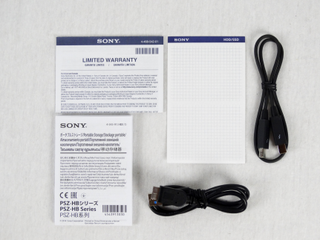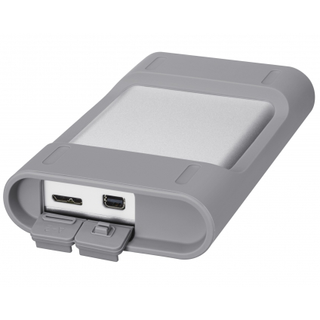Early Verdict
The Sony PSZ-HB2T serves its purpose well if you need IP-rated equipment. The price will keep hobbyists away, but it's still low enough for professionals to buy this drive without batting an eye. Inner-track sequential write performance is lower than what Sony's professional 4K video models can send to external storage.
Pros
- +
The Sony PSZ-HB system ships with cables, including the expensive Thunderbolt cable, which users often need to provide. The drive offers moderate shock resistance with the drive at rest, and it can withstand splashes of water.
Cons
- -
The price is quite a bit higher than what we would spend for an external drive, and the system weighs more than we'd like. The size can also be a problem if you want to pack the drive with consumer-grade equipment.
Why you can trust Tom's Hardware
Specifications, Pricing, Warranty & Accessories

Rugged storage is all the rage these days. We recently reviewed the LaCie Rugged RAID Thunderbolt Portable Storage, learning more about how photographers and videographers use high-capacity devices on the road to protect their work.
In a perfect world, every shoot would take place indoors with carefully-placed lighting, climate-controlled rooms and only a few people around, none of them tripping over your valuable equipment. But in the real world, these professionals often have to deal with dust, dirt and water. It shouldn't come as a surprise, then, that there are standards for grading resistance to environmental conditions.
Sony has some of the best imaging products in the world, with Alpha cameras and professional video products used to record some of the most memorable content on television. With the transition to 4K underway, even small clips take up an enormous amount of space on disk. At high-quality settings, the most powerful models can record data at 600 Mb/s (75 MB/s). They can also record directly to external storage devices like Sony's PSZ-x products.
Today, we're testing the PSZ-HB2T rugged external storage drive. This model features two interfaces, one USB 3.0 and the other Thunderbolt. The drive comes formatted in exFAT for use with other Sony products, and offers IPX5-level dust resistance and IP4X-level water resistance. This is the same rating as the previously-tested LaCie Rugged RAID, meaning the drive can take water splashing against it, but not submersion or a dusty environment with little ingress.
Specifications
MORE: How We Test HDDs And SSDsMORE: All Storage Content
MORE: Latest Storage News
MORE: Storage in the Forums
Sony offers six different SKUs in its PSZ series. There are three main groups, starting with one model that fits a 256GB solid-state drive inside the enclosure. Three models ranging from 500GB to 2TB connect via USB 3.0 or FireWire 800, just like the single SSD version. But the solution we're testing today ships with either 1TB (PSZ-HB1T) or 2TB (PSZ-HA2T) of capacity and differs from the other models by replacing FireWire 800 with a more modern Thunderbolt port.

Inside, we find a Samsung (now part of Seagate) SpinPoint M9T 5400 RPM 2TB hard drive.
Pricing & Warranty
We found the PSZ-HB1T (1TB model) for as low as $169 and the PSZ-HB2T for $273. The PSZ-HA models with FireWire 800 instead of Thunderbolt are a bit cheaper. The 1TB drive costs just $139, while the 2TB version sells for $250. The one SSD-equipped offering is priced at just $120, but it's also the lowest-capacity family member.
Accessories

Our sample shipped with two paper documents. The first is a simple statement that covers the terms of the limited warranty, while the second serves as an instruction manual (providing you're able to read its very small print). There's also a sticker included so that you can write down the enclosure's data contents.
Two cables come bundled, and they're around .6 meters long. One is a USB 3.0 cable and the other facilitate Thunderbolt connectivity. Thunderbolt cables are particularly expensive compared to most other interfaces, so we're glad to see Sony include one in its package.
Software

The system ships with software on the drive that you can install on your PC or Mac. This package lets you easily format the drive in different file systems. Some of the available options work with Apple products, while NTFS only works with Windows-based systems. The drive is formatted in exFAT from the factory, allowing you to read data from the drive on both platforms.
A Closer Look
The system ships in a brown box that lists a few of its specifications and post-format capacity. We found the travel case interesting because it looks like a film case once used for analog media.
Inside, there are separate compartments for the storage device, USB 3.0 and Thunderbolt cables.

A rubber bumper protects the drive from accidental falls. The PSZ-SA25 model with its SSD would give you more shock protection, but if course at the expense of limited capacity.
The bumper also acts as a stacking system for securely fitting more than one drive on top of another. One side has recesses, while the other has small feet that match the recesses in a stacked position.



The rubber also protrudes out from the metal case to offer better corner protection. A carefully hidden LED just behind the plastic end cover emits light when the drive is connected.
The two interface connections are hidden by form-fitted covers that give the system its IP54 dust- and water-resistance ratings. We took the main drive out of the bumper to get a better look at its dual interface.
- 1
- 2
Current page: Specifications, Pricing, Warranty & Accessories
Next Page Performance Testing And Conclusion-
Onus ReplyInner-track sequential write performance is lower than what Sony's professional 4K video models can send to external storage.
Wouldn't that be an absolute dealbreaker, particularly in the pro market?


